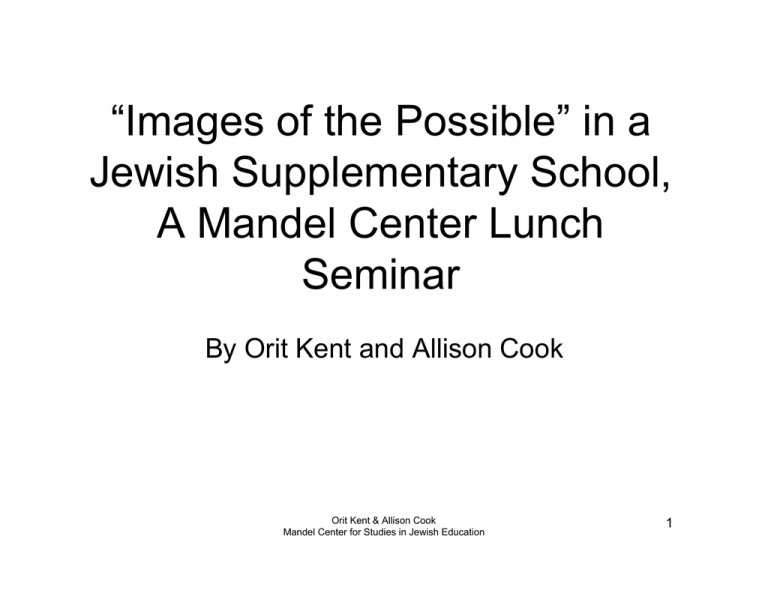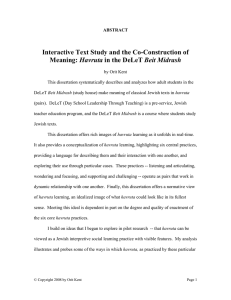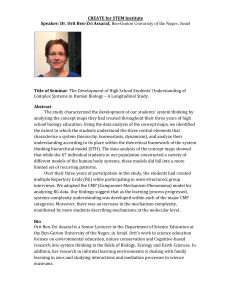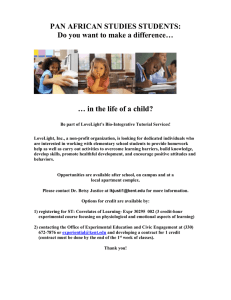“Images of the Possible” in a Jewish Supplementary School, Seminar
advertisement

“Images of the Possible” in a Jewish Supplementary School, A Mandel Center Lunch Seminar By Orit Kent and Allison Cook Orit Kent & Allison Cook Mandel Center for Studies in Jewish Education 1 Background • School based design research • Context: Jewish supplementary school, K-8, 9 teachers + principal • Intervention: Professional development course + one-on-one work with select teachers • Data: Videotapes, teacher and student work, observations, interviews Orit Kent & Allison Cook Mandel Center for Studies in Jewish Education 2 • Design Research: “Design experiments are extended (iterative), interventionist (innovative and design-based), and theory-oriented enterprises whose theories do real work in practical educational contexts.” -Cobb, et al • Reggio Emilia and Making Learning Visible Orit Kent & Allison Cook Mandel Center for Studies in Jewish Education 3 Research Questions • How can we help teachers in a Jewish supplementary school translate frameworks about havruta learning into their classrooms? • A. How can the havruta learning frameworks be adapted to help meet teachers’ learning and teaching needs in this particular context? • B. How do teachers draw on these frameworks in their planning and teaching? Orit Kent & Allison Cook Mandel Center for Studies in Jewish Education 4 Assumptions • Good theory is practical and can be taught • Importance of providing a language and creating a common language • “Making Learning Whole” (David Perkins)importance of learners seeing all components in action, experiencing them and practicing them in their classrooms Orit Kent & Allison Cook Mandel Center for Studies in Jewish Education 5 Our Hypothesis Orit Kent & Allison Cook Mandel Center for Studies in Jewish Education 6 Components of Intervention, Part I • Created professional learning community to explore collaborative learning, havruta and text study • Spent staff meeting time studying texts in havruta and debriefing experience • Mini lessons, in-class exercises, video investigations and homework Orit Kent & Allison Cook Mandel Center for Studies in Jewish Education 7 Frameworks Orit Kent & Allison Cook Mandel Center for Studies in Jewish Education 8 Examples Orit Kent & Allison Cook Mandel Center for Studies in Jewish Education 9 Components of Intervention, Part II • Targeted work with two teachers in their classrooms: meetings to plan lessons, observing lessons, meetings to reflect on lessons • Shared classroom documentation from two classes with entire staff for further learning Orit Kent & Allison Cook Mandel Center for Studies in Jewish Education 10 General impact among teachers: What did teachers do in their classrooms? • Made direct engagement with text a central part of classroom work • Spent more time listening to their students think outloud and noticing them as individual and group learners • Introduced students to well-designed havruta study in 4 out of 5 classrooms • Drew on havruta practices in designing lessons, responding to student comments and general classroom facilitation • Did not explicitly teach students havruta practices Orit Kent & Allison Cook Mandel Center for Studies in Jewish Education 11 Example #1: Making Text More Central in Kindergarten • At Kesher we place a lot of value on text-study, but this lesson was the first time that I tried reading to the Shorashim from the Torah directly, with no adaptation. I opened the book after just a short introduction, apprehensive that this was going to fall flat, maybe they are too young for this, and the language of the Torah is too difficult for them, too terse. I read the passage from Exodus telling how the Jews cried out after many years of suffering under the Egyptian yoke, and how after they cried out, God responded. I had to repeat the few lines again to the kids, but I was amazed by how they responded! These young, young children went directly to the most important questions, and directly echoed the questions that are asked in the pages of our great scholars. Orit Kent & Allison Cook Mandel Center for Studies in Jewish Education 12 Making Text More Central in Kindergarten (cont.) • Why havenʼt they cried out before? why did they wait so long? • Why did God wait until the people cried out to respond? • Why did they have to cry out loud to God? • Sometimes you cry out loud and no body helps you, did they know theyʼre going to get help? We have many childrenʼs books about the Exodus at Kesher, but their amplified storytelling sometimes tries to answer important questions before the kids have a chance to ask them. The Shorashim responded magnificently to the openness of the original Torah text. Orit Kent & Allison Cook Mandel Center for Studies in Jewish Education 13 Example #2: Dania’s 6th Grade Orit Kent & Allison Cook Mandel Center for Studies in Jewish Education 14 Goals for 6th Grade Lesson Sequence 1. become familiar with the Story of Yaakov and Esav on a factual level 2. be able to enter a playful interpretive zone rather than look for the right answers. 3. be able to gain insight or some understanding of the different qualities in each character in a deeper, less black and white way than was initially perceived. Orit Kent & Allison Cook Mandel Center for Studies in Jewish Education 15 Flow of Lesson Activities • • • • Arrange storyboards to review text Frame lesson and havruta time Havruta time Class discussion #1: Character representations • Class discussion #2: How has your understanding of the characters changed? Orit Kent & Allison Cook Mandel Center for Studies in Jewish Education 16 In Dania’s own words (see handout) Orit Kent & Allison Cook Mandel Center for Studies in Jewish Education 17 Dania’s Havruta Guidelines • When helping your partner in thinking about their character: • 1. Listen closely to what your havruta is saying • 2. Help him/her think through her ideas by asking questions such as: • What do you think that part of the text mean? Or • Why do you think that? Orit Kent & Allison Cook Mandel Center for Studies in Jewish Education 18 Dania’s Havruta Text Questions • What part did you play in the story? • What did you want? What were you feeling? Tell the story of your experience? • What were you thinking? Tell the story of your experience? What do you feel about the outcome? • If you were to choose a word or phrase from the text to explain who you are, what would it be? Orit Kent & Allison Cook Mandel Center for Studies in Jewish Education 19 Student understanding of text Josh, who played Esav, speaks: "I realized two things about Esav. He's kind of more --his word was hunt--he's really sad and disappointed. I didn’t realize how sad and disappointed he was. Not just angry. I also realized how loyal and loving he is to his father.” Orit Kent & Allison Cook Mandel Center for Studies in Jewish Education 20 Student reflections on havruta • Bob: You learn more about yourself when you do things like this…You learn about the way you think of things and this sort of helps you think about yourself and what you do in situations and helps you learn what you do. • David: You learn more about your partner…How they think about things and how they interpret the story compared to how you do, so you get to learn something about your partner and not just read a story. Orit Kent & Allison Cook Mandel Center for Studies in Jewish Education 21 “I’ve used … a lot of the content that you’ve been introducing, I’ve used, knowingly and unknowingly…” -Dania • Havruta (and my role as teacher as one who tries to enable) as a space which provides both support and also offers a more challenging way of looking at things in order to stretch one's thinking. • I constantly used the triangle metaphor: trying to create a space between learners and text where the encounter allows for creative exploration. • Enabling a safe space for exploratory talk, and encouraging and trying to model active listening, asking questions, trying to understand, helping learners explain what they mean until it becomes clearer to them, and then to others. Using different kinds of questions. --February reflections Orit Kent & Allison Cook Mandel Center for Studies in Jewish Education 22 Using Havruta in the Classroom…in Dania’s Words “Because also you were speaking before, asking me about the … the role of havruta … The amazing part was that on one hand you want to encourage students to find their own minds, but on the other hand we don’t live in, we are part of a bigger context. And we bring our uniqueness to this constellation, but we’re part of something larger than our own, and that’s exactly the point.” Orit Kent & Allison Cook Mandel Center for Studies in Jewish Education 23 THE END Orit Kent & Allison Cook Mandel Center for Studies in Jewish Education 24


